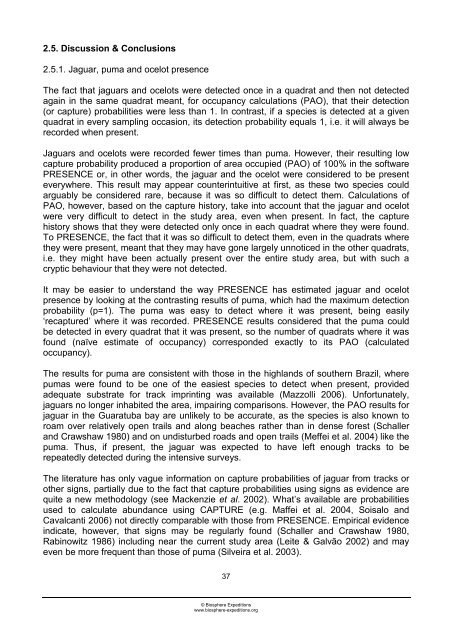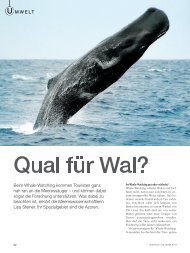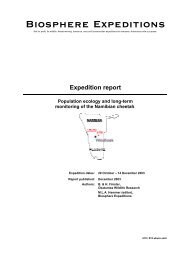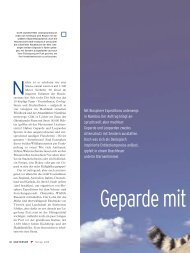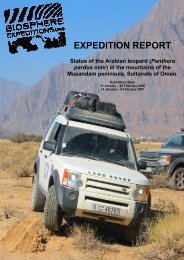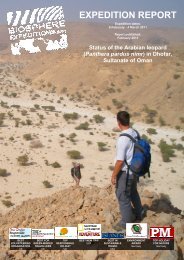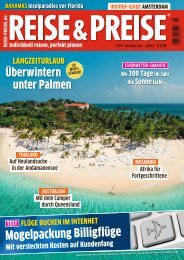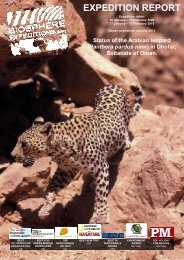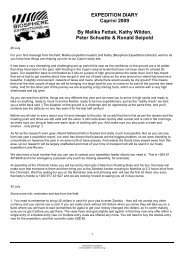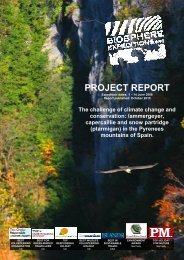EXPEDITION REPORT 2007 - Biosphere Expeditions
EXPEDITION REPORT 2007 - Biosphere Expeditions
EXPEDITION REPORT 2007 - Biosphere Expeditions
You also want an ePaper? Increase the reach of your titles
YUMPU automatically turns print PDFs into web optimized ePapers that Google loves.
2.5. Discussion & Conclusions<br />
2.5.1. Jaguar, puma and ocelot presence<br />
The fact that jaguars and ocelots were detected once in a quadrat and then not detected<br />
again in the same quadrat meant, for occupancy calculations (PAO), that their detection<br />
(or capture) probabilities were less than 1. In contrast, if a species is detected at a given<br />
quadrat in every sampling occasion, its detection probability equals 1, i.e. it will always be<br />
recorded when present.<br />
Jaguars and ocelots were recorded fewer times than puma. However, their resulting low<br />
capture probability produced a proportion of area occupied (PAO) of 100% in the software<br />
PRESENCE or, in other words, the jaguar and the ocelot were considered to be present<br />
everywhere. This result may appear counterintuitive at first, as these two species could<br />
arguably be considered rare, because it was so difficult to detect them. Calculations of<br />
PAO, however, based on the capture history, take into account that the jaguar and ocelot<br />
were very difficult to detect in the study area, even when present. In fact, the capture<br />
history shows that they were detected only once in each quadrat where they were found.<br />
To PRESENCE, the fact that it was so difficult to detect them, even in the quadrats where<br />
they were present, meant that they may have gone largely unnoticed in the other quadrats,<br />
i.e. they might have been actually present over the entire study area, but with such a<br />
cryptic behaviour that they were not detected.<br />
It may be easier to understand the way PRESENCE has estimated jaguar and ocelot<br />
presence by looking at the contrasting results of puma, which had the maximum detection<br />
probability (p=1). The puma was easy to detect where it was present, being easily<br />
‘recaptured’ where it was recorded. PRESENCE results considered that the puma could<br />
be detected in every quadrat that it was present, so the number of quadrats where it was<br />
found (naïve estimate of occupancy) corresponded exactly to its PAO (calculated<br />
occupancy).<br />
The results for puma are consistent with those in the highlands of southern Brazil, where<br />
pumas were found to be one of the easiest species to detect when present, provided<br />
adequate substrate for track imprinting was available (Mazzolli 2006). Unfortunately,<br />
jaguars no longer inhabited the area, impairing comparisons. However, the PAO results for<br />
jaguar in the Guaratuba bay are unlikely to be accurate, as the species is also known to<br />
roam over relatively open trails and along beaches rather than in dense forest (Schaller<br />
and Crawshaw 1980) and on undisturbed roads and open trails (Meffei et al. 2004) like the<br />
puma. Thus, if present, the jaguar was expected to have left enough tracks to be<br />
repeatedly detected during the intensive surveys.<br />
The literature has only vague information on capture probabilities of jaguar from tracks or<br />
other signs, partially due to the fact that capture probabilities using signs as evidence are<br />
quite a new methodology (see Mackenzie et al. 2002). What’s available are probabilities<br />
used to calculate abundance using CAPTURE (e.g. Maffei et al. 2004, Soisalo and<br />
Cavalcanti 2006) not directly comparable with those from PRESENCE. Empirical evidence<br />
indicate, however, that signs may be regularly found (Schaller and Crawshaw 1980,<br />
Rabinowitz 1986) including near the current study area (Leite & Galvão 2002) and may<br />
even be more frequent than those of puma (Silveira et al. 2003).<br />
37<br />
© <strong>Biosphere</strong> <strong>Expeditions</strong><br />
www.biosphere-expeditions.org


